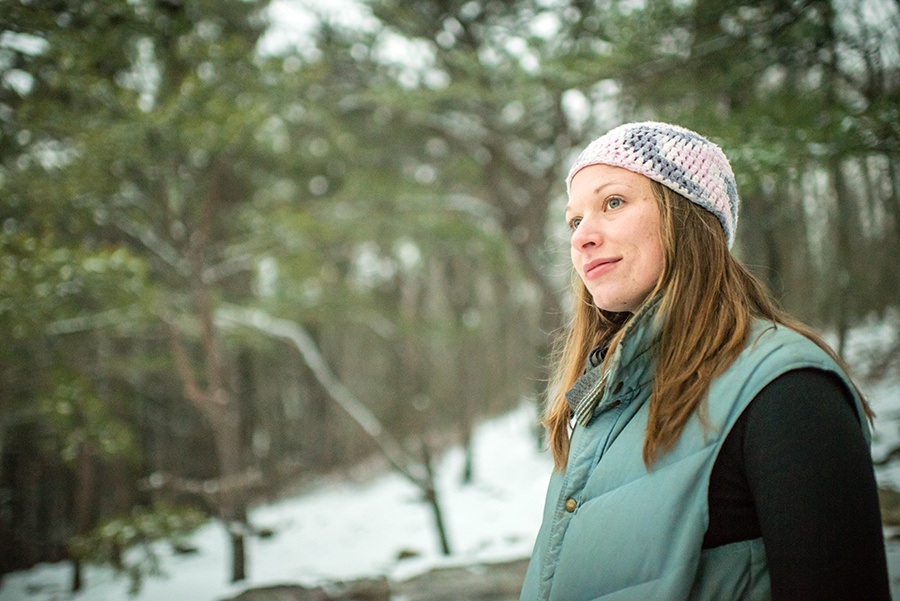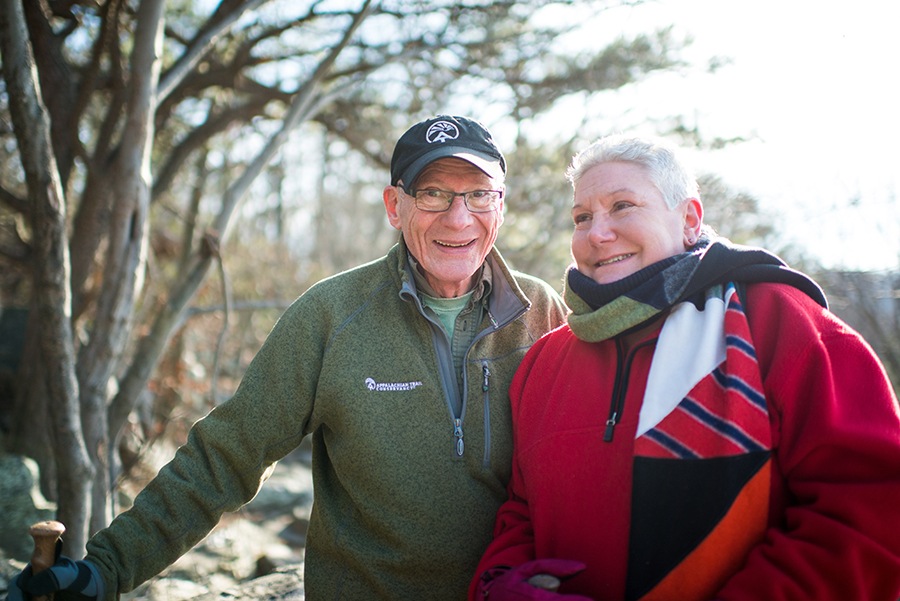Learn More
Voices from the Mountains
More Than a Hiking Trail
“The Trail provides.”
 This phrase means different things to different people. For some, hiking the Appalachian Trail (A.T.) provides a simple respite from everyday stresses or sets a new course in life. For others, the Trail provides the right people or resources at the right time: an appearance of Trail magic or a ride into town from the trailhead.
This phrase means different things to different people. For some, hiking the Appalachian Trail (A.T.) provides a simple respite from everyday stresses or sets a new course in life. For others, the Trail provides the right people or resources at the right time: an appearance of Trail magic or a ride into town from the trailhead.
But the A.T. is much more than a footpath. The headwaters of creeks, streams and lakes dot the Appalachian Mountain Range, providing clean water to millions of people. The breeding grounds and migration flyways of many bird species run the length of the Appalachian Trail corridor. High-elevation grasslands, numerous wetlands, and a variety alpine, coniferous and mixed-hardwood forests host rare and endangered plants found nowhere else on earth. The A.T. also meanders past significant cultural and historical landmarks, from Civil War battlefields to the Dover Oak — the largest and oldest tree on the entire Trail — serving as a lens into our nation’s cultural and natural histories.
According to Karen Lutz, Mid-Atlantic regional director for the Appalachian Trail Conservancy (ATC), the A.T. and its surrounding lands provide a backbone to the most significant large landscape east of the Mississippi.
“The corridor holds much more importance than only a hiking trail,” she said. “But the publicly owned Trail corridor is narrow and fragile.”
A Matter of Scale
Over the years, the National Park Service (NPS), the ATC, 31 trail maintaining clubs from Georgia to Maine, conservancy organizations and countless volunteers have accomplished much to protect and preserve the A.T. footpath and various sensitive areas along the corridor.
But to help protect the diverse natural, cultural and historic resources along the A.T.’s entire corridor, the Trail’s multi-jurisdictional complexity requires a large landscape-scale conservation strategy that involves commitments from a variety of stakeholders.
To that end, the ATC and NPS formed the Appalachian Trail Landscape Partnership, a dedicated coalition of local, state and federal partners working to educate and engage the public and the 168 towns and communities along the A.T. in safeguarding the unique values of the landscape.
“People often think about conservation from a scenic or natural resource standpoint, but there is a community aspect to landscape conservation,” said Anne Baker, ATC’s Landscape Partnership manager. “Landscape conservation helps communities protect a high quality of life and support recreation-based rural economies, while at the same time helping to preserve the A.T. experience for individual hikers. We need to think more broadly than the A.T. itself. We
need to think about how the Trail’s protected corridor and a more widely protected landscape can help communities that are adjacent to the trail remain safe, healthy and vibrant.”
“Essentially, we are trying to create an improved Appalachian Trail corridor so future generations can continue to marvel at wildlife and wild land,” said Brooks Mountcastle, environmental planner for ATC’s Mid-Atlantic regional office. ”
Value in Partnership
Large landscape conservation means maintaining not only the federally protected A.T. footpath and its corridor, but also protecting the areas surrounding the Trail from a variety of external threats and preserving them through responsible management.
These threats are varied: poorly planned commercial, energy and transportation development; suburban sprawl; noise pollution; climate change; and habitat fragmentation and destruction. Any of these threats can impact the Trail experience, but when viewed together, they put enormous pressure on efforts to maintain the larger landscape — the hillsides, valleys, water sources and wildlife — upon which so many nearby communities rely.
“There’s been a progressive diminution of Trail values, so those values need to be front and center,” said Lutz. “ATC and Trail club members and supporters need to make sure elected officials — from county and town commissioners to state and U.S. representatives — understand the A.T. has tremendous value no matter how you look at it.”
The A.T. Landscape Partnership has identified a list of 10 Priority Focus Areas, including Maine’s High Peaks, Kittatinny Ridge, Virginia’s Blue Ridge and Catawba Valley, and the Roan Highlands. All of the focus areas exemplify a diversity of conservation values, threats to these values, and opportunities to protect these special places.
“What we as conservationists do is identify the best places that are representative of natural communities,” said Jay Leutze, author of the bestselling book Stand Up that Mountain and president of the Southern Appalachian Highlands Conservancy Board of Trustees. “Once you’ve picked those, you have to knit them together. You have to make meaningful corridors for wildlife to travel. People are realizing there is a finite amount of special places that still function as natural communities. We have got to defend those places, or we’re going to lose them.”
A Specific Threat
The 185-mile-long Kittatinny Ridge, a critical migratory route for birds and a significant wildlife area, lies in the path of development and stands as an acute example of issues facing much of the corridor.
“The more the landscape surrounding Kittatinny Ridge and the A.T. corridor gets chopped up and the more development occurs high on the ridge, it imperils that wildlife, and that is a big deal,” said Lutz.
“Essentially, we are trying to create an improved Appalachian Trail corridor so future generations can continue to marvel at wildlife and wild land,” said Brooks Mountcastle, environmental planner for ATC’s Mid-Atlantic regional office.
Mountcastle described plans of the Blue Mountain Resort to build a water park and multiple residential facilities as close as 300 feet to the A.T. While conducting routine boundary monitoring activities, members of the Appalachian Mountain Club (AMC) discovered the resort was in violation of National Park Service easements. Mountain biking trails, a high-ropes canopy course and a Frisbee golf course were discovered on the easement land set aside in the 1980s to protect the Appalachian Trail. These development proposals and easement violations invite noise and light pollution, devalue the Trail’s wilderness spirit, and are antithetical to the A.T. experience. Mountcastle noted that NPS sent a cease and desist letter to the resort, but the case will likely be decided in court.
A Call to Action
When Benton MacKaye first proposed the creation of the A.T. in 1921, some thought the idea was crazy, impossible or both. But thanks to many dedicated and passionate people, the A.T. became a reality, protected by federal law under the National Scenic Trails Act, which celebrates its 50th anniversary later this year.
Similarly, the A.T. Landscape Partnership hopes to create a new movement dedicated to protecting the entire A.T. landscape. Just as the original mission brought together myriad people with various skills, so too should the effort to protect the Trail’s larger landscape.
“We have the right tools in our tool box to focus on moving forward with the goal of protecting large landscapes,” said Mark Zakutansky, director of conservation policy engagement at AMC. “Every person who sees the significance of the Trail, whether they have set foot on it or not, has a role to play in helping to protect these areas.”
 From boundary monitoring to administrative work, Zakutansky notes the numerous ways in which volunteers can help the Landscape Partnership reach its goals. Above all, he encourages people to write to their local, state, and federal representatives to convey personal stories of how much the Trail means to them.
From boundary monitoring to administrative work, Zakutansky notes the numerous ways in which volunteers can help the Landscape Partnership reach its goals. Above all, he encourages people to write to their local, state, and federal representatives to convey personal stories of how much the Trail means to them.
“Most people feel a dedication to a place or a resource like the A.T., and conservation advocacy is the number one arena that draws in new people,” he said. “Protecting the outdoors is not an easy task, and we need their voice.”
– by Alyson Browett, At-Large A.T. Community Ambassador





